Mount Gahinga is one of the eight volcanoes found within the Virunga ranges of mountains that spread to three countries – Rwanda, Uganda and the Democratic Republic of Congo. This extinct volcano is 3,474m tall and is found within the borders of Uganda and Rwanda. In Uganda, the Mountain lies in Mgahinga National Park in Kisoro District . Mount Gahinga lies between Mount Muhabura and Mount 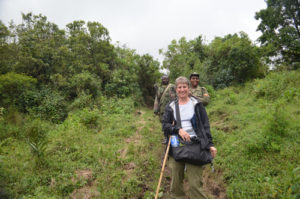 Sabinyo. It is the smallest of the three Volcanoes found in Mgahinga National Park. The name “Gahinga” means a small pile of stones in the local languages around the mountain. The mountain has a caldera which is 180m wide.
Sabinyo. It is the smallest of the three Volcanoes found in Mgahinga National Park. The name “Gahinga” means a small pile of stones in the local languages around the mountain. The mountain has a caldera which is 180m wide.
The mountain slopes contain mostly bamboo and sub-alpine kind of vegetation. The bamboo is food to primates like mountain gorillas, golden Monkeys, blue monkeys, Vervet monkeys, baboons, black and white Colobus monkeys.
Hiking Mount Gahinga
Mount Gahinga is an easy hike compared to climbing Mount Sabinyo or Muhabura. However, one needs to be fit and mentally prepared to complete the hike. It takes 6 hours to complete the activity depending on the determination and fitness of the hiker. To qualify for the hike, one needs to get a hiking permit from the park offices. The permits can be got at $75 on the same day of the hike. There is no need for booking in advance.
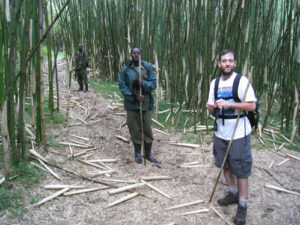 Hiking Mount Gahinga starts at 7:00am with briefing at the park headquarters with one of the park Rangers. The Rangers share information about the mountain including its history and position among the Virunga volcanoes. Hikers will be informed about the nature of the hike and how to prepare in the best possible way. There are stops at various points of the mountain to allow hikers rest, eat, take photos and enjoy the beautiful scenery. After the briefing, everyone is given a free hiking stick and those who wish to use porters can hire them.
Hiking Mount Gahinga starts at 7:00am with briefing at the park headquarters with one of the park Rangers. The Rangers share information about the mountain including its history and position among the Virunga volcanoes. Hikers will be informed about the nature of the hike and how to prepare in the best possible way. There are stops at various points of the mountain to allow hikers rest, eat, take photos and enjoy the beautiful scenery. After the briefing, everyone is given a free hiking stick and those who wish to use porters can hire them.
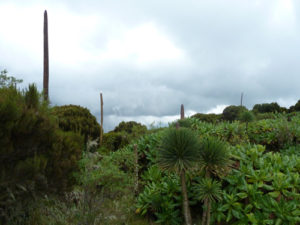 The first part of the hike involves going through thick bamboo forest at the foot of the mountain. This section is relatively easy as the ground is level. This is also the area where you are most likely see the golden monkeys, gorillas and other primates. Buffaloes roam the slopes of the mountains and can dangerous to hikers. It is one of the reasons why an armed Ranger is always assigned to accompany hikers. After the bamboo forests, the mountain gets steeper until the summit. By the time one reaches the summit, they would have gone passed several bat-filled volcanic caves and other volcanic features on
The first part of the hike involves going through thick bamboo forest at the foot of the mountain. This section is relatively easy as the ground is level. This is also the area where you are most likely see the golden monkeys, gorillas and other primates. Buffaloes roam the slopes of the mountains and can dangerous to hikers. It is one of the reasons why an armed Ranger is always assigned to accompany hikers. After the bamboo forests, the mountain gets steeper until the summit. By the time one reaches the summit, they would have gone passed several bat-filled volcanic caves and other volcanic features on 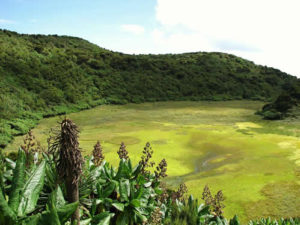 the mountain slopes. The summit of Mount Gahinga is quite different from those of Sabinyo and Muhabura because of its unique summit. At the summit, there is a large shallow crater swamp with unique sub-alpine plants like Senecio, Lobelia thrive and Alchemillia.
the mountain slopes. The summit of Mount Gahinga is quite different from those of Sabinyo and Muhabura because of its unique summit. At the summit, there is a large shallow crater swamp with unique sub-alpine plants like Senecio, Lobelia thrive and Alchemillia.
The summit offers amazing vies of the other distant volcanoes in the Virunga ranges as well as the Rwenzori mountains. You can spot Mount Mahabura and Sabinyo very closely giving you the temptation to also reach their summits in the next days. Take as many photos as possible with your groups and also the distance scenes. Descending down is much easier than climbing up but one needs to exercise caution especially when climbing down the ladders to avoid sliding or falling down. You might find our article about Mount Kilimanjaro interesting.
Information about hiking Mount Gahinga
- The distance from Kampala to Mgahinga National Park is about 483 kilometers. It takes between 8 to 10 hours of driving on well paved tarmac road before reaching Kisoro town. An alternative and shorter route is to arrive from Kigali in Rwanda and cross over to Uganda. From Queen Elizabeth National park, the driving time is 3 hours while from Lake Mburo, the time taken driving is 6 hours. To avoid the long road trips, some hikers may choose to use a chartered plane from Entebbe Airport or Kajjansi airstrip all the way to Kisoro and them hire a car to the park. You would need to secure accommodation for the night as you prepare for the hike the next day.
- The mountain gets very cold as one ascends towards the summit. Altitude sickness is a real possibility while hiking Mount Gahinga. You need to come with the necessary medication in case you get sick.
- For the most memorable experience, hiking Mount Gahinga should be combined with gorilla trekking and a visit to Queen Elizabeth National Park for a more complete safari. Queen Elizabeth National Park is one of the best wildlife conservation areas in Africa. The park has lions, leopards, antelopes, warthogs, hyenas, elephants, buffaloes, hippos and so much more. There is no better place to spot Africa’s birds than the Kazinga Channel of Queen Elizabeth National Park.
What to do after climbing Mount Gahinga
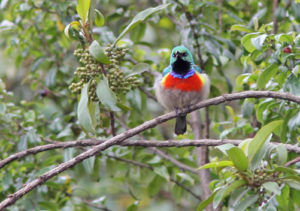 Birding Watching: The dense forests at the foot of Mount Gahinga and the other nearby volcanoes are home to about 180 species of birds. 12 of them are endemic to the park. Birds can be spotted in the bamboo forest and at the gorge between Mount Sabinyo and Gahinga. The best time for birding in Mgahinga National Park is between April to May or October to November. Expect to spot the alpine chat, black kites, the blue headed coucal, bronze sunbirds, double collared sunbirds, dusky turtle dove, olive pigeons, olive thrush, olive woodpeckers, paradise fly catchers, pin-tailed whydah, regal sunbirds, Rwenzori batis, the speckled mouse bird, stray seedeaters and the white necked raven.
Birding Watching: The dense forests at the foot of Mount Gahinga and the other nearby volcanoes are home to about 180 species of birds. 12 of them are endemic to the park. Birds can be spotted in the bamboo forest and at the gorge between Mount Sabinyo and Gahinga. The best time for birding in Mgahinga National Park is between April to May or October to November. Expect to spot the alpine chat, black kites, the blue headed coucal, bronze sunbirds, double collared sunbirds, dusky turtle dove, olive pigeons, olive thrush, olive woodpeckers, paradise fly catchers, pin-tailed whydah, regal sunbirds, Rwenzori batis, the speckled mouse bird, stray seedeaters and the white necked raven.
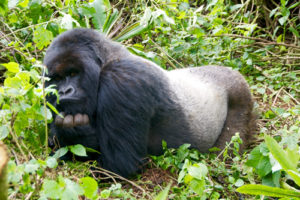 Gorilla Trekking: This is the main activity in Mgahinga Gorilla National Park. There is only one habituated gorilla group in Mgahinga but with arguably the most Silverbacks for a group in Uganda. While tracking the gorillas, one can also spot other smaller primates like Colobus and golden monkeys. Gorilla trekking in Mgahinga starts at 8:00am with briefing at the park offices in Ntebeko. Only eight people can track a gorilla family in a day and visitors only have one hour to observe them closely. Gorilla permits cost $600 in Uganda.
Gorilla Trekking: This is the main activity in Mgahinga Gorilla National Park. There is only one habituated gorilla group in Mgahinga but with arguably the most Silverbacks for a group in Uganda. While tracking the gorillas, one can also spot other smaller primates like Colobus and golden monkeys. Gorilla trekking in Mgahinga starts at 8:00am with briefing at the park offices in Ntebeko. Only eight people can track a gorilla family in a day and visitors only have one hour to observe them closely. Gorilla permits cost $600 in Uganda.
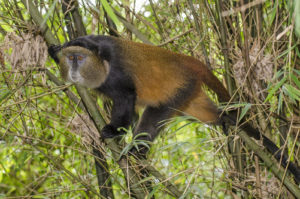 Golden Monkey Trekking: Golden monkeys are one of the cutest primates you will ever encounter. They are considered endangered and only found in the Virunga Region (Volcanoes, Mgahinga and Virunga National Park). Mgahinga National Park has the highest population of recoded Golden Monkeys – over 3,500. Golden monkey tracking is very popular in Mgahinga but visitors can choose to go for the golden monkey habituation experience instead. This experience allows visitors to study the primates for more than one hour under the guidance of very experienced trackers and sometimes researchers. Golden monkeys don’t move too much and tend to stay in the same area for the night compared to the mountain gorillas. The permit for the golden monkeys cost $100 and can be got on short notice.
Golden Monkey Trekking: Golden monkeys are one of the cutest primates you will ever encounter. They are considered endangered and only found in the Virunga Region (Volcanoes, Mgahinga and Virunga National Park). Mgahinga National Park has the highest population of recoded Golden Monkeys – over 3,500. Golden monkey tracking is very popular in Mgahinga but visitors can choose to go for the golden monkey habituation experience instead. This experience allows visitors to study the primates for more than one hour under the guidance of very experienced trackers and sometimes researchers. Golden monkeys don’t move too much and tend to stay in the same area for the night compared to the mountain gorillas. The permit for the golden monkeys cost $100 and can be got on short notice.
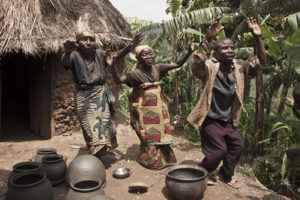 Cultural Experience: Visiting the Batwa people is without doubt the most interesting cultural encounter in Uganda. The Batwa lived as gatherers and hunters in Mgahinga National Park for over 450,000 years before they were evicted forcefully by the government to protect the gorillas and other wildlife in the forest. The Batwa pygmies have never fully adapted to life outside the forests in the park. While with them, you will learn about their current struggles and life outside the forest. The Batwa experience in Mgahinga is different from that in Bwindi because you are led by the Batwa themselves. By participating in the Batwa Trail, you help contribute to the well being of one of Africa’s most interesting indigenous tribes. Prepare to be entertained afterwards with traditional dances, stories and drama.
Cultural Experience: Visiting the Batwa people is without doubt the most interesting cultural encounter in Uganda. The Batwa lived as gatherers and hunters in Mgahinga National Park for over 450,000 years before they were evicted forcefully by the government to protect the gorillas and other wildlife in the forest. The Batwa pygmies have never fully adapted to life outside the forests in the park. While with them, you will learn about their current struggles and life outside the forest. The Batwa experience in Mgahinga is different from that in Bwindi because you are led by the Batwa themselves. By participating in the Batwa Trail, you help contribute to the well being of one of Africa’s most interesting indigenous tribes. Prepare to be entertained afterwards with traditional dances, stories and drama.
Nature walks: The nature walks in Mgahinga National Park are arranged to allow visitors get up-close with nature. The walks are arranged to see the bamboo forests, birds, swamps like Rugezi, surrounding villages and lakes like Mutanda. During these walks, expect to encounter forest creatures, wild vegetation and the local communities living at the edge of the forest. The scenery in Mgahinga can be breathtaking especially a few weeks after the main rains have stopped.
Note: Mgahinga National Park is less visited compared to Bwindi Impenetrable National Park. This has left the park relatively unspoiled. Visitors can explore the park privately.
Accommodation while climbing Mount Gahinga
There are several lodges within Mgahinga National Park that one can choose to stay for the night before and after climbing the mountain. These hotels offer budget, mid-level and Luxury service. The choice depends entirely on one’s interests and budget. The accommodation facilities include Mucha Hotel in Kisoro, Mount Gahinga lodge, Virunga Hotel, Travelers Rest Camp, Kisoro Tourists Hotel and Amajambere Iwachu community camp. For today, we focus on Mount Gahinga Lodge.
Mount Gahinga Lodge
Mount Gahinga Lodge is owned by Volcanoes Safaris. The lodge is ideal for those who are interested in gorilla trekking alongside climbing mount Gahinga. It is strategically located close to the park entrance. 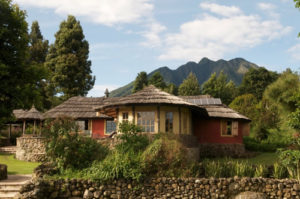 Mount Gahinga Lodge has 8 standard bandas (papyrus roof and walls made of stone). Each banda is named after one of the eight Virunga volcanoes. Some of the bandas have double and twin beds. All rooms have a private balcony, free Wi-Fi, ample lighting, flush toilet, warm showers, storage chests, a table and a fireplace. The scenery around the hotel is amazing and residents can marvel at the scenery from a specially built terrace. Other important services and amenities include a small gift shop for local souvenirs, a massage room, beautiful gardens and a swimming pool.
Mount Gahinga Lodge has 8 standard bandas (papyrus roof and walls made of stone). Each banda is named after one of the eight Virunga volcanoes. Some of the bandas have double and twin beds. All rooms have a private balcony, free Wi-Fi, ample lighting, flush toilet, warm showers, storage chests, a table and a fireplace. The scenery around the hotel is amazing and residents can marvel at the scenery from a specially built terrace. Other important services and amenities include a small gift shop for local souvenirs, a massage room, beautiful gardens and a swimming pool.

